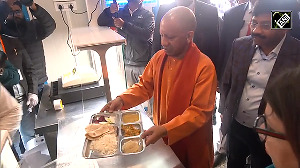 My article in Business Standard about people fighting against Posco has brought various responses in the past fortnight.
My article in Business Standard about people fighting against Posco has brought various responses in the past fortnight.They call for clarification and further discussion. The question is about the value of current livelihoods of the people in coastal Orissa.
Is earning from betel nut farming being exaggerated to reinforce the view that people are fighting projects because they are better off today?
The equally valid question then is, why are the people so apparently poor "if they are earning Rs. 10 lakh to Rs. 17 lakh per hectare each year", as I had said?
Questions arise that speak of our inability to understand two things: one, what makes people, poor in our eyes, oppose growth we believe in; and two, what makes people poor?
First, an explanation: my colleague Sayantan Bera, who travelled across the Jagatsinghpur region of Orissa to meet villagers resisting the Posco takeover, will tell you the problem is our misinterpretation of reality.
Land ownership in this area is not measured in hectares but in decimals - one hectare is equal to 250 decimals.
Most people own some 10 to 30 decimals of land, which is 1/25 or 1/30 of a hectare.
So, based on the profit estimate I gave in my previous article, a household earns Rs. 40,000 to 70,000 per hectare for the land it holds - not a lot of money if it is seen in this way and certainly not enough to make them middle-class rich.
But the important issue is that this earning is "good" enough for them to fight till death the acquisition of their land. The reason is that this money comes on a monthly basis, and comes year after year.
The earning of Rs. 3,000 to 4,000 every month per household takes people marginally above the wretchedly low poverty line (also called the starvation line).
But this earning comes regularly - it is their subsistence - and, more importantly, it gives them economic security year after year.
It is this equation with land that we find difficult to understand. I saw this when I visited other poor regions that are resisting industrial growth, which comes with our promise of progress.
In Nimalapedu village of forested, tribal Andhra Pradesh, I was confronted with the same confusion: a poor village with no access to electricity, housing or other signs of economic wealth had fought, and won, against the calcite mining project of the powerhouse of Birla.
Then I visited Kalinganagar, where 13 tribals had been killed fighting against a steel project.
The question "why" was even more incomprehensible when you considered the people fighting change were poor - they lived in mud-and-thatch
The rainfed agricultural fields with low produce will be exchanged for houses in colonies built by the company for resettlement.
From our eyes, they looked impoverished and marginal. In our view, the future looked only brighter.
These tribal farmers are different from the relatively prosperous farmers in Gujarat, fighting against the takeover of their land and waterbody for the Nirma cement plant.
But even in the Nirma case, where farmers are more linked to the markets and more capable of "adapting" to new industrial economic futures, the livelihood option that land provides is valued intensely.
It is this difference between them and us we cannot comprehend.
Everywhere I have been, people resisting takeover have told me that "land is their mother. They cannot sell it".
This is a sentiment that most of us (literate and urban Indians) cannot grasp. For us, land is property, which we buy and sell, to suit our interest.
We also cannot understand this obduracy because we do not understand the value of land-based occupations.
This is partly because for so long we have discounted the option of land-based livelihoods in our economic vision.
We have only understood farmers are desperately poor, driven to suicide and migrating to cities.
All this is true, but it is equally true that land-based occupations provide sustenance to millions.
And if the voices coming from Jagatsinghpur, Nimalapadu and Kalinganagar and the scores of mutinies across the country are to be believed then this land-based occupation is still worth fighting for.
It is time we understood the struggle for land, water and forests as fight for livelihoods.
If we do, we will deal with protesters with respect, giving them the right to decide whether to approve of the takeover of their land and asking them for the price they are willing to accept in return.
I say this knowing that in our estimation the availability of land and water will be the biggest impediment to economic growth.
If we understand this connection then we will also learn to take the current occupations more seriously.
We will then work to improve economic returns from the land so that it can compete with the returns from profitable and economic activities. I don't believe the challenge is to pit one economic future against another.
But it is certainly a challenge to accommodate the view that there are many ways to growth and well-being.
The aim is to get there. Together.
sunita@cseindia.org












 © 2025
© 2025